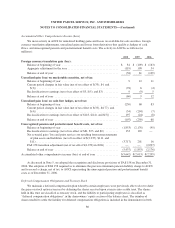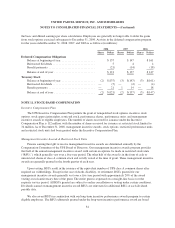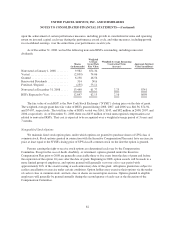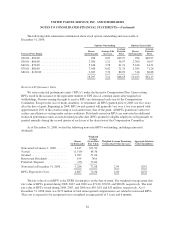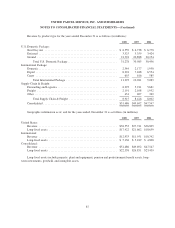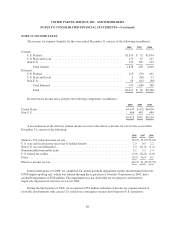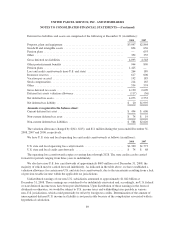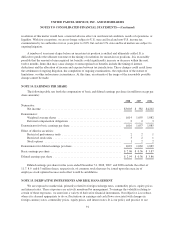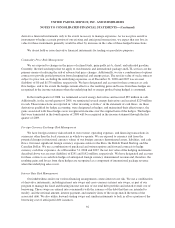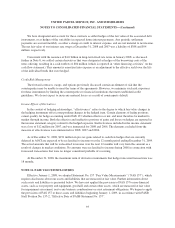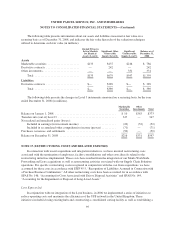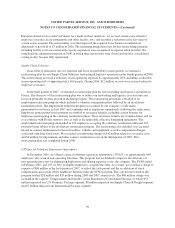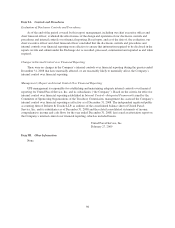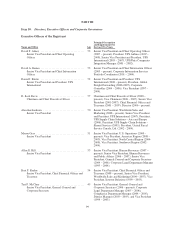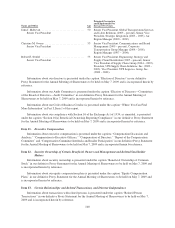UPS 2008 Annual Report Download - page 101
Download and view the complete annual report
Please find page 101 of the 2008 UPS annual report below. You can navigate through the pages in the report by either clicking on the pages listed below, or by using the keyword search tool below to find specific information within the annual report.
UNITED PARCEL SERVICE, INC. AND SUBSIDIARIES
NOTES TO CONSOLIDATED FINANCIAL STATEMENTS—(Continued)
In July 2006, the FASB issued FASB Interpretation No. 48, “Accounting for Uncertainty in Income Taxes—
an Interpretation of FASB Statement No. 109” (“FIN 48”). FIN 48 requires that we determine whether a tax
position is more likely than not to be sustained upon examination, including resolution of any related appeals or
litigation processes, based on the technical merits of the position. Once it is determined that a position meets this
recognition threshold, the position is measured to determine the amount of benefit to be recognized in the
financial statements. We adopted FIN 48 on January 1, 2007. The cumulative effect of adopting this standard was
to recognize a $104 million decrease in the January 1, 2007 balance of retained earnings.
The following table summarizes the activity related to our unrecognized tax benefits (in millions):
Tax Interest Penalties
Balance at January 1, 2007 ................................................ $373 $ 88 $ 6
Additions for tax positions of the current year ................................. 13 — —
Additions for tax positions of prior years ..................................... 34 13 2
Reductions for tax positions of prior years for:
Changes based on facts and circumstances ............................... (12) 9 —
Settlements during the period .......................................... (49) (34) (2)
Lapses of applicable statute of limitations ................................ (4) (1) —
Balance at December 31, 2007 ............................................. $355 $ 75 $ 6
Additions for tax positions of the current year ................................. 28 — 1
Additions for tax positions of prior years ..................................... 63 33 5
Reductions for tax positions of prior years for:
Changes based on facts and circumstances ............................... (46) (9) (2)
Settlements during the period .......................................... (9) (2) —
Lapses of applicable statute of limitations ................................ (3) — —
Balance at December 31, 2008 ............................................. $388 $ 97 $ 10
The total amount of gross unrecognized tax benefits as of December 31, 2008 and 2007 that, if recognized,
would affect the effective tax rate was $206 million and $189 million, respectively. We also had gross
recognized tax benefits of $583 million and $567 million recorded as of December 31, 2008 and 2007,
respectively, associated with outstanding refund claims for prior tax years. Therefore, we had a net receivable
recorded with respect to prior year income tax matters in the accompanying balance sheets. Additionally, we
have recognized a receivable for interest of $135 million and $116 million for the recognized tax benefits
associated with outstanding refund claims as of December 31, 2008 and December 31, 2007, respectively. Our
continuing practice is to recognize interest and penalties associated with income tax matters as a component of
income tax expense.
We file income tax returns in the U.S. federal jurisdiction, most U.S. state and local jurisdictions, and many
non-U.S. jurisdictions. As of December 31, 2008, we had substantially resolved all U.S. federal income tax
matters for tax years prior to 1999. In February and July 2008, the Internal Revenue Service (“IRS”) completed
its audit of the tax years 1999 through 2002 and tax years 2003 through 2004, respectively, with only a limited
number of issues that will be considered by the IRS Appeals Office by the end of 2009. In late 2008, the IRS
began the initial planning phase of the income tax audit for tax years 2005 through 2007. Along with this audit
for tax years 2005 through 2007, the IRS is currently examining non-income based taxes, including employment
and excise taxes on transportation of property by air and fuel purchases, which could lead to proposed
assessments. The IRS has not presented an official position with regard to these taxes at this time, and therefore
we are not able to determine the technical merit of any potential assessment; however, we do not believe that the
90


